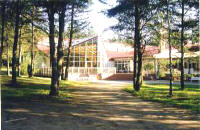Ecology Camp in Taiwan
The planning of Environment-Friendly Camp Site

Preface
In June 1972 United Nations has summoned for an international environment conference in Stockholm. Afterwards, a "Declaration on Human Environment" was given. Ten years later, in May 1982, another meeting was held in Nairobi to review the progress on the last declaration and the related programs. During this meeting, a resolution was passed demanding solemnly that all Governments and their people must work hard to improve and preserve the world environment.
In June l992, after another ten years, the meeting was held again, this time in Rio De Janeiro. The name was "Environment and Development". A unanimous recognition was reached and the Rio Declaration comprising of 27 principles was given. Besides these major international conferences, international gatherings on specific environmental issues, such as the "Climate Change Meeting" in Kyoto in December last year were held more than 100 times.
People have awakened from the unlimited exploitation of the limited resources on earth in the past and feel the strong correlation among all the inhabitants on this planet, may there be a distance of thousands of miles apart. Today we all live in this village named "Earth" under the same atmosphere that is less than 20 miles in thickness.
Following the economical development, increased per capita income, urbanization, the prevalence of cars, camping - outdoor leisure activities which are beneficial to the sound development of both body and mind of the modern people - have flourished in Asia areas such as Japan, Taiwan and Korea. In view of the people's demand, government and private enterprises have invested sizable funds for the development of camp sites. Because of the abundant fund and the fact that many planners' incorrect camping concept, there is an "over-construction" of camp sites. This not only has caused a waste of the resources and destruction of environment, but also a situation that a true camper won't to see.
Hua-Tung Valley, situated between Central Mountains and Coastal Mountains, has formed a narrow river valley plain from Hua-Lien Creek at north and Bei-Nan Creek at south. The valley has very rich natural resources, beautiful pastoral scenery and unique humane assets, which are excellent resources for tourism. The Tourism Bureau, under the direction of the Executive Yuan, has founded "Hua-Tung Valley National Scenic Area Administration". In order to provide ideal campsites that are close to the nature and to promote camping tours for the nationals; the Administration has planned to develop the Lee-Yu-Tan (Carp Lake) campsite next to the lake. I was honored to be a consultant to the campsite plan. Based on the reasons stated above, we hope that, by using the environment-friendly method, we can construct an ecology campsite out of it.
The Concept of Environment-Friendly Camp Site
An integral plan of the camp site comprises of these conditions of the market, resources, nature, land, installations and locality and we shall be dealing with installation condition here. We can summarize the integral plan of an environment-friendly camp installations into following four points:
- A. The development of the camp site shall be done with the least destruction of the natural environment.
-
1. At the survey stage we shall investigate and record thoroughly the terrain, appearance, and natural inhabitant of plants and animals.
2.The rule for development shall be for small areas rather than large areas.
3. We shall preserve the nature inhabitant of plants and animals which can provide valuable information for environment education.

- B. Use environment-friendly method to construct the camp site
- 1. Other than main roads which shall be paved with asphalt, all secondary roads and service paths shall be graveled.
2. The gutter system, concept for the main drainage, all the rest shall be V-shaped with pebble bed for natural infiltration of water.
3. Porous type of materials shall be used for the bank of the waterway in the camp to preserve the growth of plants and animals.

-
4. The pitch shall be on the natural piles of earth with the local grass planted on it. The parking berth and driveway shall be paved with local pebbles.
5. The buildings shall perfectly be of wooden material.
- C. Use wisely the natural resources
-
1. All buildings shall be designed to have natural ventilation and luminescence.
2. Camp site shall have a solar system for supply of hot water.
3. For the disposal of waste, all garbage shall be classified for recycle purpose. Leftovers shall be decomposed. Grease or waste water shall be biochemically treated before drained - the entire process shall not cause any damage to the natural environment.

- D. Overall surroundings shall match with the local culture and natural environment
- 1. The color and shape of the buildings shall match with natural environment. Also the local traditional architecture and customs shall be taken into consideration.
2. The main entrance shall match with the local industry. Using stone as materials for the styling , mingled with local plants.
Summarizing the above four concepts and weighing the balance environment and development, we hope this camp can be an Arkland. That is, to embrace the maximum species of plants and animals in the least limit of developing areas.
Without destruction of the multiplicity of the terrain, using the porous type of environment-friendly construction method, energy conservation type of building design, we can minimize the installation of non-humanistic modern facilities and let the camp site preserve the originally nature environment. Then the campers can achieve a kind of symbiosis with the natural inhabitants within the camp site, and therefore the camp site can be perpetual.
February 1999 (Asia-Pacific News No.4)














